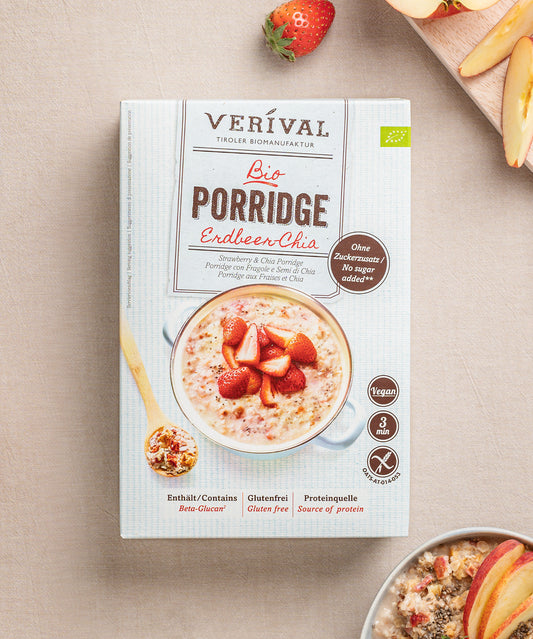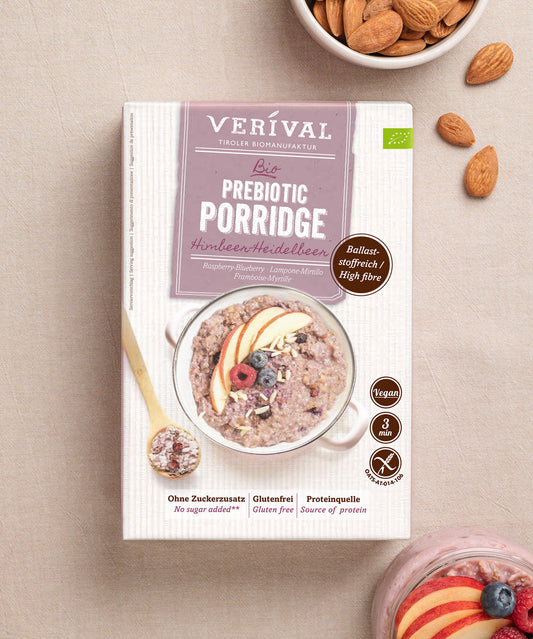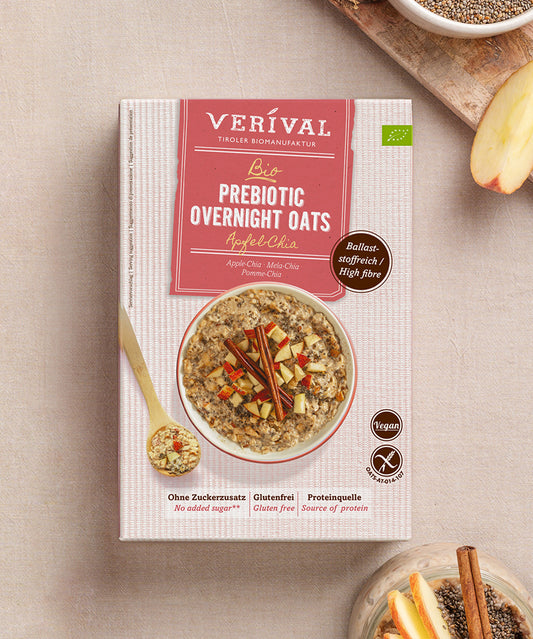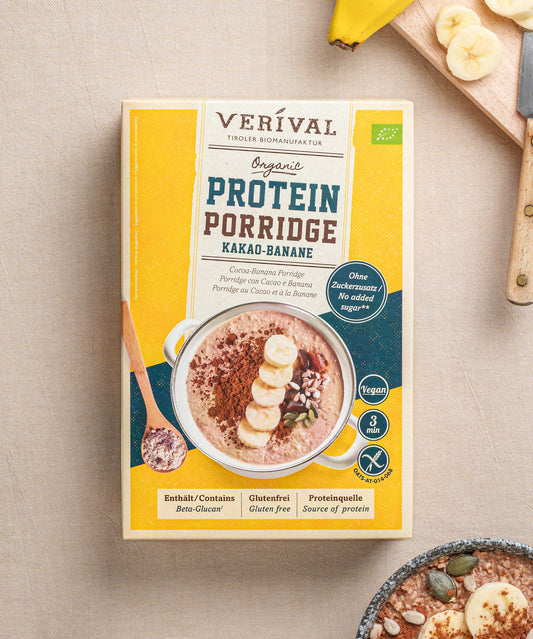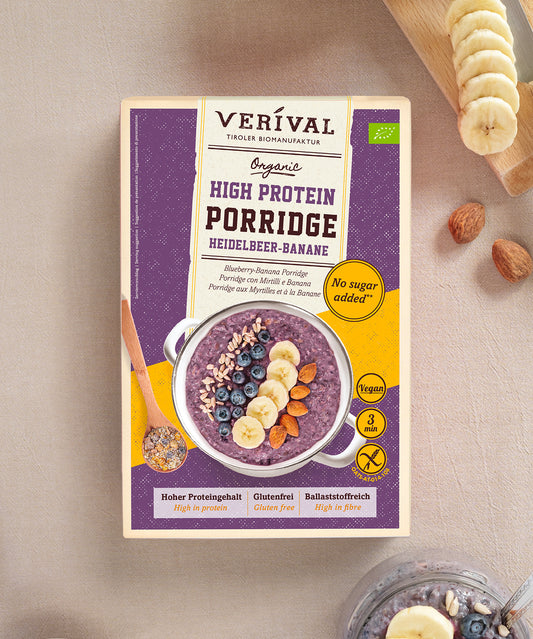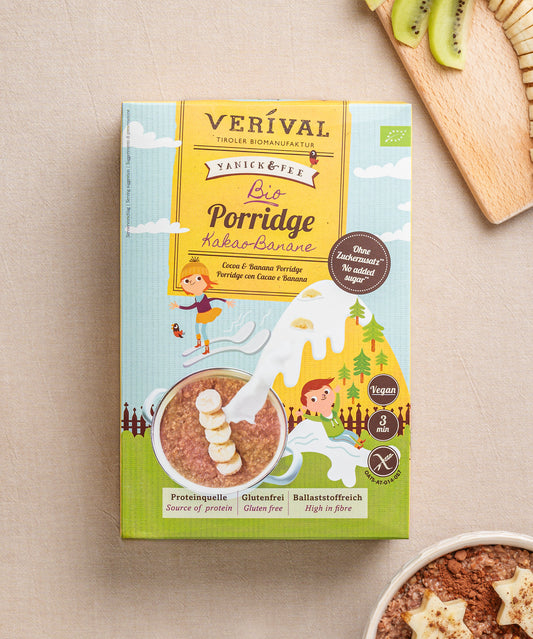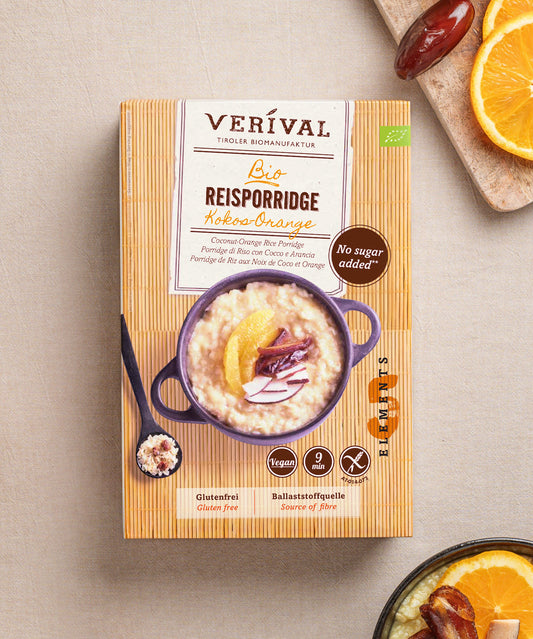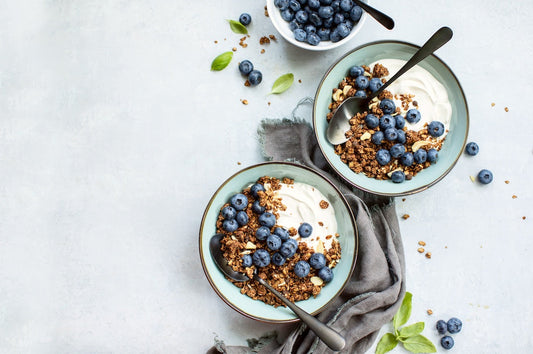If you want to build muscle, you need plenty of calories. That's because carbohydrates, fats and proteins provide energy and support regeneration. But how much is plenty? How many calories does your body actually need to build muscle? We will now take a closer look at these questions and also clarify what the ideal diet for athletes looks like and how the calorie calculator can help you.
How to build muscle
Building muscle is an important goal for many athletes. It makes you stronger, helps you achieve that beach body and makes you feel good about yourself. But how does muscle building actually happen? And what role does the calorie calculator play in it?
Start the day with a sporty breakfast with Verival Porridge – try it now
When we talk about muscle building, we are talking about hypertrophy. Muscle fibre hypertrophy, to be precise. This involves an increase in the cross-section of the muscles, which makes the muscles stronger and the body look more athletic. So much for the definition.
But how do you build muscle? And which factors are particularly important for building muscle?
Hypertrophy – how to make your muscles grow
To make your muscles grow, you need two coordinated factors above all: training that provides sufficient stimuli and recovery during which your body recovers and strengthens. Incidentally, your nutrition is extremely important for recovery.
Eating right after training – find out more
Effective training is always adapted to your current fitness level. If you are just starting out, strength training with your own body weight can be perfectly adequate. A few push-ups, lunges or squats provide sufficient training stimuli for beginners.
If you are already more advanced, you can use weights. Barbells, dumbbells or even strength training machines can be of great help to you.
However, it is important not to overdo it. Targeted training breaks and a suitable balance of training and recovery are extremely important. Two to four training sessions per week can help to ensure this.
A third important factor is nutrition. Let's take a closer look at what exactly you should be aware of.
Macronutrients – high-calorie energy suppliers
When it comes to the ideal diet for athletes, there are a few things you should know. Firstly, there are macronutrients. These are nutrients that contain calories. Secondly, there are micronutrients. These have no calories, but are important for numerous bodily functions.
Let's start with macronutrients. This group includes carbohydrates, fats and proteins. While carbohydrates and fats are primarily used as energy sources, the body uses protein as a building material.
However, the three macronutrients have different numbers of calories and fulfil different functions:
| Macronutrient | Calories per gram | Main functions in the body |
| Fats | 9 kcal per gram | Largest energy supplier Recycling fat-soluble vitamins Protection for organs |
| Carbohydrates | 4 kcal per gram | Fast energy supplier Important for brain and muscles |
| Proteins | 4 kcal per gram | Building material for tissue Transport function in the blood and in the cells |
Micronutrients – calorie-free wonders
Unlike macronutrients, micronutrients do not contain any calories and therefore no energy. However, their functions are just as important.
The micronutrients at a glance :
- Vitamins
- Fat-soluble vitamins (A, D, E & K)
- Water-soluble vitamins (B & C)
- Minerals
- Bulk elements (magnesium, calcium, etc.)
- trace elements (iron, zinc, etc.)
The functions of micronutrients range from a resilient immune system to skin renewal. To build muscle and train regularly for it, you should make sure you have a strong immune system.
In addition, you should pay particular attention to which vitamins and minerals you need as an athlete. Iron, magnesium and vitamin D play a particularly important role here.
Calorie calculator – a must-have for building muscle?
But how many calories does the body need to build muscle? There is no simple answer to this question. In fact, a number of factors influence your calorie requirement. Fortunately, there are calorie calculators that take all these factors into account.
The only thing you have to do is enter the necessary data. These usually include your height, your current weight and your age.
Basal metabolic rate or active metabolic rate – what does the calorie calculator calculate?
Basically, the difference between basal and active metabolic rate is easy to explain. As the name suggests, the basal metabolic rate is the amount of energy that your body needs in any case.
For most people, the basal metabolic rate is around 1,800 to 2,200 calories. This means that your body needs exactly this amount of calories to maintain all bodily functions. All this under the assumption that you would not move.
However, since that will be the case, you need a second factor for your individual determination of calorie needs: the active metabolic rate. The name itself already indicates the function.
The active metabolic rate describes the amount of calories that your body needs in addition, depending on how physically active you are. Since it would be very cumbersome to calculate every little physical activity individually, there are the so-called PAL values.
The active metabolic rate as a PAL value:
| PAL Value (Activity Level) | Description |
| 1.2 to 1.3 | Only sedentary or reclining activity |
| 1.4 to 1.5 | Exclusively sedentary activity with little or no strenuous leisure activity |
| 1.6 to 1.7 | Sedentary activity, sometimes standing and walking with little or no strenuous leisure activity |
| 1.8 to 1.9 | Predominantly walking or standing work |
| 2.0 to 2.4 | Physically strenuous professional work or very active leisure activities |
It's best to be honest with yourself and assign yourself to the appropriate description. Now all you have to do is multiply your basal metabolic rate by your PAL value to get your daily calorie requirement.
However, always pay attention to the value calculated for you by the calorie calculator. Otherwise, you may double-count your active metabolic rate.
Our Verival calorie calculator, for example, uses the information you enter to calculate your individual daily requirement. Including basal metabolic rate and active metabolic rate!
This is how to use the calorie calculator for targeted muscle building
If you want to build muscle and get stronger, there is something else you should bear in mind. This is because the calorie calculator usually calculates your so-called maintenance calories.
The maintenance calories represent the amount of calories you need to maintain your current weight. However, if your goal is to gain weight in the form of muscle mass, you should calculate a little more calories. Especially if you are already advanced.
200 to 400 calories in addition to your calculated daily requirement should be sufficient in most cases. It's best to weigh yourself daily and calculate your weight gain on average. This way, you can adjust your calories at any time and avoid unwanted weight gain through fat.
Example calculation with our Verival calorie calculator :
| Gender | Age | Height | Weight | Activity Level | Daily Requirement |
| Male | 24 | 182 cm | 78 kg | Moderate activity (2 to 3 times a week physically active) | 2,884 kcal + 300 kcal = 3,184 kcal |
| Female | 35 | 168 cm | 65 kg | Low activity/sedentary (1 to 2 times a week physically active) | 1,910 kcal + 300 kcal = 2,210 kcal |
If you use your BMI to classify your weight, you should be careful. This is because the BMI of strength athletes and bodybuilders can be somewhat misleading. Due to their above-average muscle mass, you as a muscular athlete are quickly classified as overweight, even though your body fat percentage is perfectly fine.
These foods help you build muscle
To get the desired daily requirement that the calorie calculator has calculated for you, you should eat the right foods. Ideally, these should be nutrient-rich and so high in calories that they can cover your daily needs.
Oats are a particularly suitable food. This is because oat flakes or bran are rich in complex carbohydrates and vegetable proteins . Together with the natural fibre content, oats provide plenty of energy at breakfast time.
In the form of porridge or overnight oats, oats are quick to prepare and the ideal sports breakfast for your active lifestyle. If you top your porridge with fresh fruit, you get an optimally balanced breakfast thanks to the vitamins and minerals it contains. Nuts or seeds can provide an extra portion of protein.
Conclusion: the calorie calculator helps you build muscle
Of course, you don't necessarily need a calorie calculator to build muscle. You can, of course, just eat and take a look at the scales every day. However, it may take some time before you have determined your individual needs.
However, since the calorie calculators are extremely simple and provide relatively accurate results, you should at least consider using them. You should be aware, however, that the values will not match your individual values 100 per cent. That said, they are fairly accurate guidelines that can serve as a basis.
This way, you can find your actual calorie requirement more quickly and lose or gain weight in a more targeted way, simply by maintaining your weight.


